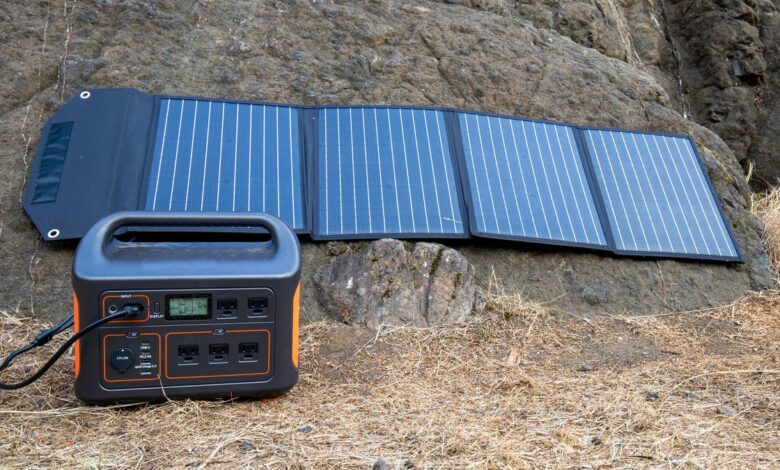How Solar Generators Can Power Your Gadgets During Outdoor Adventures

Most of us would find it hard to live without our devices, even when we’re out enjoying nature. Whether we’re out for a quick hike or camping deep in the woods, who among us wouldn’t want to have their phone charged? Running out of battery is not only frustrating, it’s also dangerous, especially when you’re far from home.
The good news is that this is absolutely possible, even if you are miles away from the nearest power outlet. Solar generators, which are essentially a portable power station connected to a solar panel, can charge your devices and draw extra energy from the sun.
“Ultimately, this is convenient, mobile power that allows us to be on the go, whether we’re camping, off-grid or on an extended vacation,” said Shawn Budiac, vice president and division manager of merchandising at Batteries Plus.
Here’s what you need to know about how solar generators can become part of your next camping trip.
Solar generators and camping
If you’ve never heard of a portable power station, it’s essentially a large battery that you can carry around and use to power your electronics. These portable batteries are considered “solar generators” when paired with portable solar panels, which in turn can replenish the power station to keep your power supply going.
This has many uses when camping. You can charge your phone, or if you are working far from the forest, charge your laptop. Or you can plug in some LED lights to brighten up the campsite or an oscillating fan to keep the bugs away.
“It’s not just comfort, but also, depending on where you’re camping, peace of mind,” Budiac said.
Choosing the Best Solar Generator for Your Camping Needs
The best solar generator for you depends entirely on what you specifically want to get out of it. Here are some technical specifications that can help you decide.
Battery capacity
There is a fairly large battery range available. Solar generators can provide as little as 300 watt hours and as much as 1,500 watt hours or more.
Budiac said that 300Wh, for example, can handle about 25 cell phone charges, run a fan for a few hours, or power LED lights for a few days. As you get to 600Wh and beyond, all those capacities increase proportionally, but the generators get bigger and heavier.
“It just becomes a matter of portability,” Budiac said. He recommends thinking about what you really want to use it for and getting just the right amount of power so you’re not lugging around extra weight.
Solar capacity
Again, there are many options. A 100-watt solar panel is fairly common, but they can also go up to 300 watts. “The great thing is that there are so many options these days,” Budiac said.
But again, there’s a tradeoff between power and portability. A larger panel will charge the generator faster, but it will also be bulkier. Under perfect conditions at the highest sun, a 100-watt panel would take about three hours to fully charge a 300-Wh generator, Budiac said.
Keep in mind that unless you are really vigilant about the timing of your solar charging, you probably won’t get 3 hours of perfect sunlight every day. So expect your panels to take longer to charge the power station in most scenarios.
Output
Battery capacity isn’t the only thing to consider. There’s also power, and while larger batteries tend to have more power, there are limitations. And if you’re going to be running power-hungry devices, you’re going to need plenty of power, especially to get things started.
For example, if you want to plug in a coffee maker, it might draw an initial peak of 1,200 watts when starting up, but then drop back down to 500 watts once the appliance is running. In that case, a 600-watt solar generator would probably be able to handle the appliance, since the wattage is low enough, despite the short start-up peak.
Budiac recommends thinking about the types of devices you plan to plug into your generator. Make sure the model you buy has a high enough wattage to handle the power draw of those electronics. Also consider the types of output ports you want: a mix of USB and standard A/C outlets, for example.
Loading speed
In peak conditions, a solar panel can charge a generator in about the same time as a wall outlet, Budiac says. But most of the time, you won’t be lucky enough to charge your panels during peak sunlight. In that case, “it’s always faster to charge from a wall outlet,” Budiac says.
Also keep in mind that you probably won’t be draining your generator battery all the time. So if you only need to charge from 60% to 100%, it will take less time to charge.
Lifespan
How long does your battery last? “The lifespan depends on how you use it and how often,” Budiac says.
Many solar generators have a two-year warranty, but they usually last much longer. A solar generator that is used occasionally for camping trips and kept fully charged during storage can last more than five years, Budiac says.
Weight
You probably understand by now that these things can be heavy. Make sure you don’t buy too much battery capacity, as this will result in an unnecessarily heavy solar generator.
Budiac said smaller models can weigh as little as 10 pounds, while larger models can weigh 40 pounds or more. Think about whether you can (or want to) carry that much weight on your camping trips.
How much does a solar generator cost?
Portable power stations typically cost about $1 per watt-hour, Budiac says. That means a 300-Wh generator, for example, could cost about $300. The price can drop a bit for higher-wattage models. Expect to pay a few hundred more dollars for portable solar panels.
Frequently Asked Questions
How long does it take to charge a solar generator?
It depends on how big your power station and solar panels are. Many portable solar panels are around 100 watts. That would take a 600Wh generator around six hours to charge in peak conditions.
How do I maintain a solar generator?
Keeping it fully charged between uses can extend the life of the battery. Also try to store it in a dry place that is not too cold or too hot.




